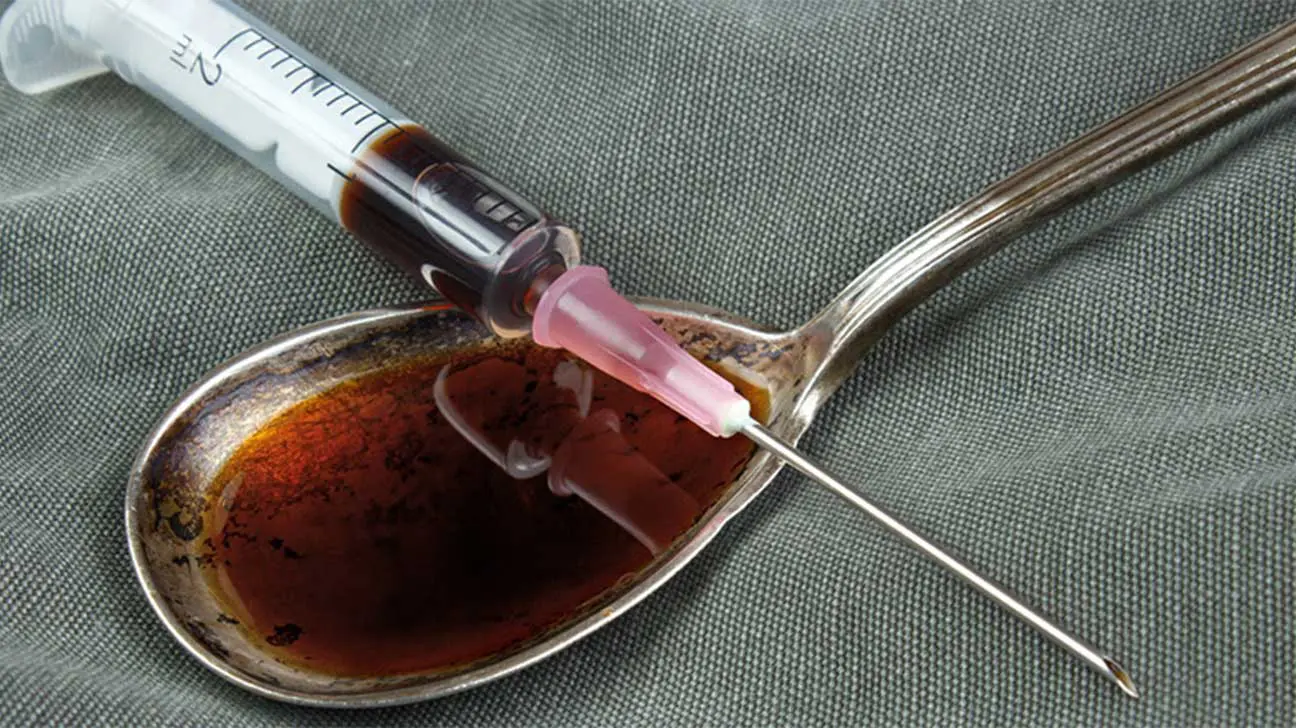
Liquid heroin can come in a few different forms. The term “liquid heroin” can refer either to lean, which is a concoction of heroin with other drugs, or to a liquid form of black tar heroin.
This is a less common form of using heroin, though it has gained popularity in recent years.
Liquid heroin is usually stored and sold in small eye droppers. This makes liquid heroin difficult to detect as compared to other forms of the drug.
Heroin can also be smoked, snorted, or injected. With injection, the drug is melted down to liquid form and then drawn into a syringe.
Liquid heroin differs from the liquid form of injected heroin in that it’s typically snorted, not injected.
Learn more about the different types of heroin
Liquid Heroin May Refer To A Codeine Drug Cocktail
Lean (also called purple drank, sizzurp, barre, and Texas tea) may refer to a form of liquid heroin.
It’s a sort of codeine drug cocktail made from a concoction of cough syrup, soda, and hard candy. Those who use lean may call the concoction liquid heroin.
When the ingredients are mixed together, lean can create a sense of euphoria, drowsiness, and intense relaxation, effects similar to heroin.
Liquid Heroin May Refer To Black Tar Heroin
Some also refer to liquid heroin as black tar, a form of heroin that’s dark in color and sticky like roofing tar, or hard like coal.
The black color comes from crude and impure processing. Because of this, those who use black tar heroin usually dissolve and filter the drug before injecting it into the body.
This form of heroin can either be injected or smoked. Though snorting black tar is possible, it’s not as common as other methods.
Who Uses Liquid Heroin?
Various forms of heroin are being used in growing numbers by younger demographics. Lean liquid heroin is a popular recreational drug among teens and young adults.
Many abuse lean because they believe prescription drugs are safer than illicit drugs, but high amounts of codeine can lead to serious effects like a slowed heart rate and breathing issues.
How Liquid Heroin Came To The U.S.
Black tar is primarily produced in Mexico. Because of its proximity to Mexico, the western part of the U.S. sees a majority of black tar use.
It’s also been produced and exported by South American and Asian countries.
Because black tar is much lower in purity than powder heroin, commonly produced in Afghanistan, it’s much cheaper to buy.
As more people began to discover this cheap form of heroin, production and distribution from Mexico to the U.S. skyrocketed.
Effects Of Lean Liquid Heroin
Lean liquid heroin has a number of serious and potentially fatal effects.
A few of the more mild effects include:
- nausea
- impaired vision
- memory loss
- dizziness
- shortness of breath
More severe and potentially life-threatening effects include:
- seizures
- hallucinations
- respiratory depression
- brain damage
- cardiac arrest
Some also add alcohol, which can be dangerous.
Mixing alcohol in with the other ingredients in liquid heroin may lead to:
- difficulty breathing
- extreme drowsiness
- impaired motor skills or reaction time
- overdose
Effects Of Black Tar Liquid Heroin
Black tar has the highest potential for medical complications because of its impurities.
Though it can produce a number of heroin-like short-term effects that a person might be looking for, there is a major risk of long-term damage.
Serious complications and health risks with using black tar liquid heroin include:
- addiction
- overdose
- brain damage
- depression
- heart infection
- insomnia
- liver and kidney disease
Treatment Options For Liquid Heroin Abuse
Whether you or a loved one are struggling with liquid heroin, treatment is available.
Participate in programs such as:
- intensive outpatient treatment, an outpatient program that allows you to remain at home while receiving treatment
- partial hospitalization program, a high-intensity outpatient treatment program
- inpatient rehab, a full-time treatment option for those who would like 24-hour care
- medication-assisted treatment (MAT), a medically-based program that uses medications such as Suboxone or methadone to treat the symptoms of withdrawal
Find Treatment For Liquid Heroin Addiction
We’re here to help. Call our helpline today and speak with a representative about the many different options in addiction treatment.
We’ll help you to find a heroin treatment center and program that’s the right fit for you or your loved one.
Addiction Resource aims to provide only the most current, accurate information in regards to addiction and addiction treatment, which means we only reference the most credible sources available.
These include peer-reviewed journals, government entities and academic institutions, and leaders in addiction healthcare and advocacy. Learn more about how we safeguard our content by viewing our editorial policy.
- Indiana Prevention Resource Center — Types of Heroin
https://iprc.iu.edu/training/courses/heroin/a_01_04_01.html - National Institute on Drug Abuse (NIDA) — Heroin Drug Facts
https://www.drugabuse.gov/publications/drugfacts/heroin - National Institute on Drug Abuse (NIDA) — Heroin Research Report
https://www.drugabuse.gov/publications/research-reports/heroin/overview - U.S. National Library of Medicine — Heroin in brown, black and white: Structural factors and medical consequences in the US heroin market
https://www.ncbi.nlm.nih.gov/pmc/articles/PMC2704563/


